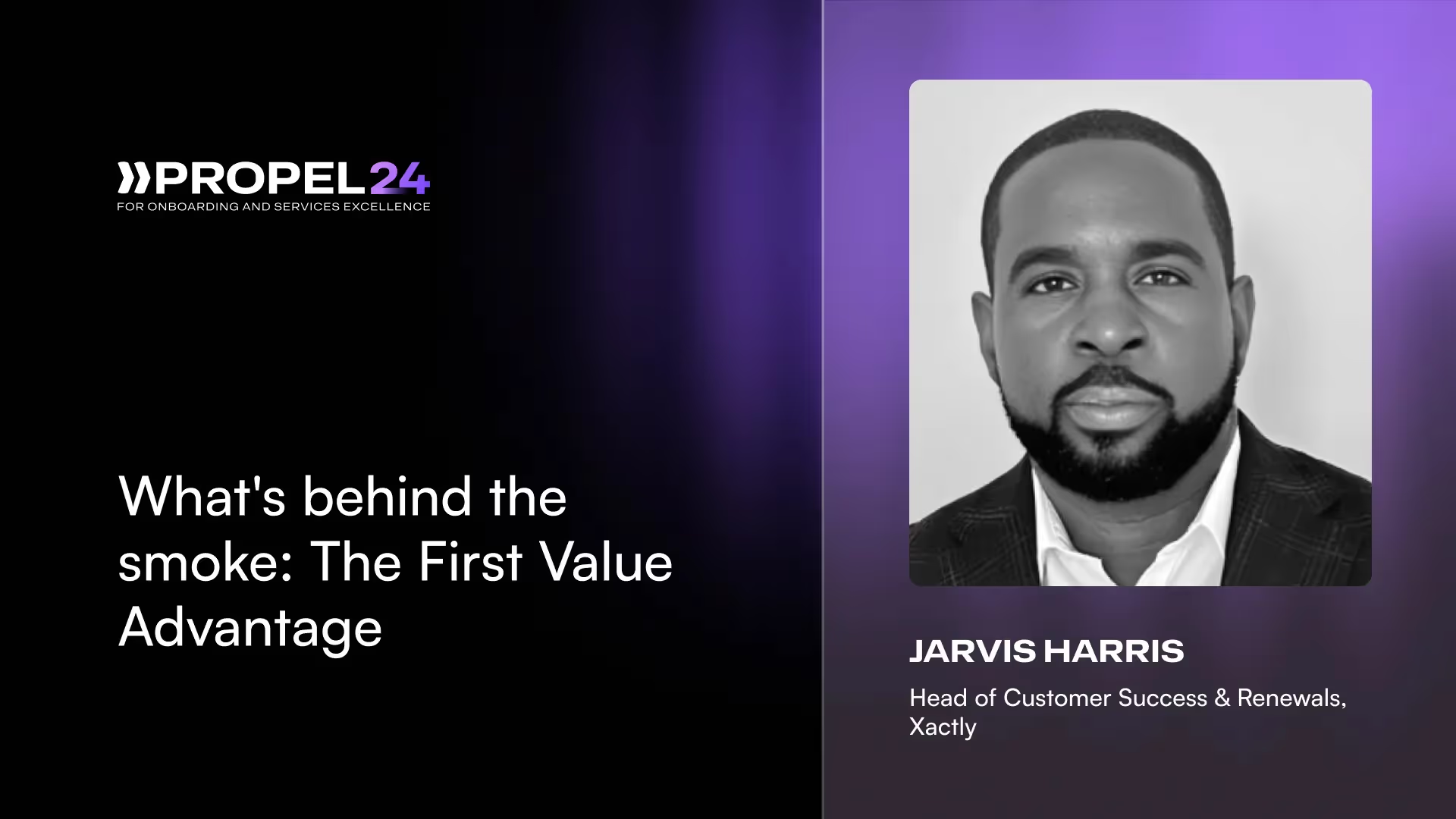In this hype-driven era, it's easy to get lost in the smoke of buzzwords and fleeting trends. However, true success lies beyond the smoke in the tangible benefits of delivering genuine value to customers.
At Propel24, Jarvis Harris, the Head of Global Customer Success and Renewals at Xactly, explains the concept of the first value advantage.
In his Propel24 session, he discussed:
- Breaking down first value
- The AWW framework for understanding first value
- 30/60/90-day segmentation
- Customer success stories: The power of first value
Defining first value: Perception vs. reality
First value is the intersection of your customer's perception and your reality of how quickly they receive value from your product.
Often, businesses make great strides internally—implementing systems, engaging users, and ticking all the right boxes—yet the customer still feels they haven't received value. This discrepancy between your internal progress and the customer's perception can be a major stumbling block.
Understanding and bridging this gap requires a deep dive into several critical areas, starting with the customer's journey and their engagement with your product.
Understanding "AWW": Are your customers following or leading?
To drive first value, you need to understand whether your customers are following your lead or attempting to lead the process themselves, or, as Harris calls it, the ‘AWW’.
Understanding AWW enables you to take proactive steps to drive customer value and success, ensuring sustainable outcomes throughout the entire lifecycle.
Let’s dive deeper into AWW and understand how to differentiate and manage these dynamics effectively:
A: Are your customers following or leading?
When your customers lead you
These customers try to take control by setting the agenda, creating timelines, and dictating milestones. This approach can be disastrous as it may lead to misaligned expectations and unsuccessful implementations. Key indicators of a leading customer include:
- Setting the agenda themselves often leads to a lack of clear direction.
- Creating timelines without your expert input may be unrealistic.
- Defining milestones with a singular focus, ignoring broader success factors.
- Not aligning resources properly can derail the project.
When your customers follow you
Your customers rely on you to set the agenda, provide the framework, suggest timelines, and approve milestones. As the vendor, you are the expert, and it is your responsibility to guide them through the process. This involves:
- Setting the agenda: As the expert, you know the critical steps and milestones.
- Providing the framework: You offer a structured approach that ensures all necessary components are addressed.
- Suggesting the timeline: Based on your expertise, you propose realistic timelines that align with the customer's goals.
- Approving milestones: You establish checkpoints to ensure that both you and the customer agree on progress and next steps.
Ensuring customers follow your lead lets you better manage their expectations and guide them toward successful outcomes.
W: What's stopping you?
Several factors can slow down implementation and product absorption (note, not adoption). Adoption implies using the product, whereas absorption means understanding its nuances and integrating it effectively into the customer's workflow. Key obstacles include:
1. Lack of a comprehensive enablement plan
An incomplete or poorly constructed enablement plan can severely hinder the onboarding process. This plan should be detailed and holistic, covering all aspects necessary to drive customer success.
When developing an enablement plan, it is essential to focus on several key elements. Firstly, ensure that customers have clear training guidelines and understand their responsibilities.
The plan should be created with a joint agreement between you and the customer, outlining the steps, stages, and timeline.
A structured approach is necessary, specifying what needs to be learned and when such as starting with foundational training and progressing through advanced onboarding.
You should also identify and address user personas based on their specific needs to ensure comprehensive support and engagement throughout the process.
2. Presence of only the PS team
Relying solely on the PS team can hinder progress if the customer success team is not introduced from the start. Introducing CS after go-live is ineffective because they must be involved from day one to engage the right personas and maintain momentum.
PS departments often focus on goals rather than outcomes, so it’s crucial to ensure that the initial implementation meets high-level outcomes to drive successful first value attainment.
3. Lack of customer commitment
Lack of proper resources often leads to missed deadlines and project delays. Before starting a project or implementation, ensure the customer has allocated the necessary resources.
A lack of commitment can lead to scope creep, where additional tasks disrupt the process. It's essential to prevent drift and maintain focus to ensure successful project outcomes.
W: What’s working?
First value focuses on achieving quick-time-to-value (Q-TTV). Here are the essential drivers to ensure this:
Value derived within 90 days based on one use case
Focus on delivering tangible value within 90 days by concentrating on a single, well-defined use case. This ensures that the implementation is not overly complex and allows for measurable success within a short timeframe.
Value tailored to one business unit or segment's needs
Customize the value proposition to address the specific needs of one business unit (BU) or segment. This targeted approach ensures the solution meets precise requirements, making the value more immediate and impactful.
Outcome tied to a near-term (within a quarter) board or revenue target
Align the project's outcome with a near-term board or revenue target, ensuring the benefits are visible within a quarter. This focus helps in securing buy-in from stakeholders by demonstrating quick wins that contribute to broader business goals.
A 45-day enablement plan
Ensure that both influencers and the targeted user base complete their enablement plans within 45 days. Identify key influencers who can advocate for the product and train them alongside the primary users. This strategy amplifies the product's benefits through enthusiastic endorsements and comprehensive user understanding.
30/60/90-day segmentation
30 days
For Monthly Recurring Revenue (MRR) products, it is crucial to demonstrate value within 30 days to justify the monthly payments and prevent churn.
Self-service products, which cater to self-sufficient customers, should deliver quick value as these users prefer minimal interaction.
Ensuring that they can independently achieve key actions within the first month is essential to meeting their expectations and encouraging continued use.
60 days
It is important to deliver noticeable value within 60 days for products that address a specific need. This requires focused solutions and proactive guidance from the vendor.
Leading customers and showcasing expertise allows the vendor can build trust and achieve a specific use case milestone within this period, demonstrating the product's effectiveness and reliability.
90 days
Enterprise solutions, which often involve complex implementations and multiple teams, should aim to achieve a significant outcome within 90 days.
Focusing on a single, impactful result helps maintain project visibility and keeps customer enthusiasm and engagement high. Achieving this milestone within the first three months is critical for sustaining momentum throughout the project.
Beyond 90 days
For large customers with Annual Recurring Revenue (ARR) exceeding $1 million, extended timelines may be necessary due to the complexity of their implementations. Demonstrating progress through phased value delivery is essential.
Achieving interim milestones, such as system integrations, training, and initial report generation, within 120 to 180 days ensures continuous value demonstration. This approach maintains customer confidence and showcases steady progress throughout each implementation phase.
Customer success stories: The power of first value
Achieving first value with customers sets the stage for continued success and demonstrates the immediate impact of your product. Here’s how you can showcase and capitalize on the power of first value.
Internal success stories
Share success stories within your company to highlight how certain customers hit first value. Detail what they did and how they achieved it. This not only boosts morale but also provides a blueprint for future implementations.
External success stories
Encourage customers to share their success externally. When customers share their success stories, it reinforces their satisfaction and showcases how quickly they achieved first value with your product. In exceptional cases, these customers can become referenceable, speaking to prospects or being featured on your website.
Transitioning from time-to-value to quick-time-to-value
Defining and achieving quick-time-to-value helps you create raving fans. When customers experience a swift onboarding process and realize value shortly after, they are more likely to become enthusiastic promoters of your product. Customers who have never experienced such rapid value will become strong advocates for your product.
Account management and upsell opportunities
The first value objective serves as a calling card for your account management and client executive teams. If you consistently deliver first value, upsells and additional bookings become easier because customers already trust your product's efficacy.
Website and references
Highlighting first value success stories on your website and with reference customers showcases your business agility. This competitive advantage can attract prospects and build credibility in your marketplace.
You can achieve the first value advantage by focusing on these strategies and ensuring robust planning and execution. This will drive success and establish long-term, successful relationships with your customers.






















.webp)
